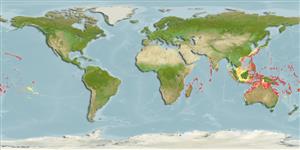| Native range |

|
| Paracirrhites arcatus AquaMaps Data sources: GBIF OBIS |
Issue
The species Paracirrhites amblycephalus (Bleeker 1857) is considered as valid in Eschmeyer (CofF ver. May 2011: Ref. 86870). Please send references, or more studies are needed.
Human uses
Fisheries: of no interest; aquarium: commercial
Phylogenetic diversity index
(Ref. 82805)
PD50 = 0.5156 many relatives (e.g. carps) 0.5 - 2.0 few relatives (e.g. lungfishes)
Trophic Level
(Ref. 69278)
3.6 ±0.4 se; Based on diet studies.
Resilience
(Ref. 69278)